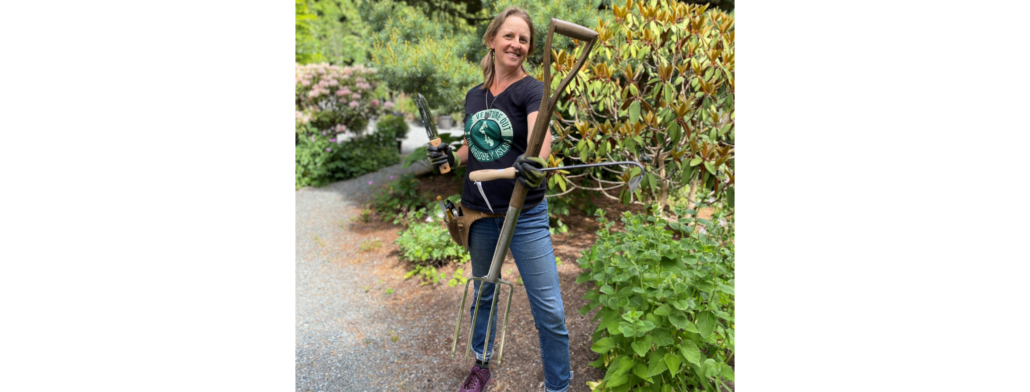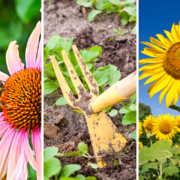Summer Garden Maintenance Tips
Summer is peak season in our landscapes! Gardeners and plants alike are working hard. Get the most from your efforts and help your perennials, shrubs and trees do their best. Follow these tips for a lush, healthy, productive landscape through the summer and beyond.
Watering
Appropriate watering is critical to keeping plants growing and healthy. It is also important to consider our natural resources, and water as little as we can get away with while keeping our plants healthy. The best way to do this is to not water too early. When we water a lot at the beginning of summer we “train” our plants to be lush. Then, when the real heat and drought stress of summer sets in, our plants have a hard-to-sustain amount of foliage. We are forced to water like crazy to help them sustain this growth. Cultivate more resilient plantings by being conservative with supplemental water during May and June.
To really understand how much to water, it helps to know the needs of each plant as well as what kind of soil you have. In general, it is best to water deeply and less often, versus frequent and shallow. Watering slowly/at a low rate, and for a longer duration of time, ensures the water soaks deeply through the root zone. This helps roots establish in the soil horizons that stay moist and cool. In contrast, short shallow waterings encourage plants to root only in the top few inches of soil. This is the layer that is first to dry out in the heat of the sun. So set the hose on a trickle, place it at the crown of your plant, set a timer for 30 minutes to a few hours depending on the size and type of plant, and address other garden tasks while your plants get a nourishing deep drink.
Established gardens need less water than new plantings. In established beds, hopefully you can get away with watering just every couple of weeks or once per month during the summer. Of course, this depends on what types of plants you are growing. Not all plants are drought tolerant. Support these plants with less-frequent deep soakings to keep them going.
New plantings will need watering to help them through the hot dry months of summer. In general, perennials take 1 – 2 (rainy, wet) winters to really establish in the garden. Shrubs need 2 – 3 winters, and trees need 3 – 5. Any plants in your garden that are younger than this will need extra water to get established. In an ecologically ideal gardening world, we would be choosing drought-tolerant plants that fit our summer-dry climate. But even these plants need help to get established. Once established, it is possible to have a low-water or water-free garden!
Sandy soils do not hold water well. Gardeners with sandy soils will need to water more often, and for shorter duration since the water will run through. Help sandy soils hold water by adding organic material. Compost or Soil Building Conditioner is great for this.
Clay soils retain water, but it can hard to get the water to penetrate. Slow and steady is best here. Long trickle soaks are best. A slow steady trickle allows the water to permeate the clay and soak in, rather than running off. Add lots of organic material as well as calcium carbonate lime to help clay soils break up/form soil aggregates. As with sandy soils, compost or Soil Building Conditioner is great for this.
Feeding
In general, spring is the best time to fertilize. The exception to this is flowering annuals and veggies. It is good to feed these plants through the summer to keep the production – of blooms and fruits – coming. A liquid bloom-booster fertilizer is great. I like to give dilute amounts with each watering (according to package instructions). With any plant you plan to overwinter, it is best to stop fertilizing by early August to allow plants to harden off.
Weeding
It is always important to stay on top of weeding! Eliminating weeds means that your desired plants get all the water and soil fertility resources for themselves. Removing weeds before they set seed means fewer weeds next year!

My three most favorite weeding tools are a hori-hori (a Japanese weeding knife), a spading fork, and a triangle hoe weeder. The hori-hori is great for digging out tap-rooted weeds. Spading forks are indispensable for colonizing plants like Buttercup and Sorrel that propagate from root pieces. A fork will loosen the soil without cutting the roots, enabling you to remove the whole root mass while leaving little root system behind to propagate. The sharp triangle hoe weeder is great for slicing annual weed seedlings off just below the soil surface. You can also use the long point for jabbing out root masses of older more established weeds.
Mulching
Keeping soils covered with an organic mulch such as soil building conditioner or compost or woodchips is a great way to help retain soil moisture and suppress weeds. For more information about mulching, and which products are a good fit, watch this video!
Deadheading
Keep the blooms coming all summer – deadhead! Flowers are the reproductive organ of a plant; their job is to attract pollinators and create seeds. Once this job is through, the plant will direct its energy to ripening the seed. If it is flowers you want, remove fading blooms to encourage your plant to continue to bloom. This is especially important for the flowering annuals we use for big show, like Geraniums and Petunias, etc. But it still holds true for perennials and shrubs.
Harvesting
Like deadheading, keep harvesting all your summer veggies to keep more coming. Remove the fruit at its peak, before the seeds inside ripen, and your plant will be signaled to keep going.
Summer pruning
Growth vigor of trees and shrubs winds down in July and August. This can be a great time to lightly prune plants that are prone to a vigorous, suckering response. Trees such as Magnolia, Plum, Cherry, Apple, Crabapple, Japanese Maples, Dogwoods, Styrax (this is the short list; there are others) benefit from being thinned and shaped in summer even more than in winter.
Disease control & Insect management
Unlike gardeners, plants can’t go jump in a lake, or retreat to the hammock with a cool beverage when summer just gets to be too much. All the hard work of summer can be hard on a plant. This can leave them vulnerable to insects, fungus and other random ailments. Keeping your plants mulched and watered (and fertilized if needed) is the best way to prevent issues, but sometimes help is needed. Organic controls are always my first line of defense. Insecticidal soap is great for most soft-bodied insect infestations such as aphids and leafhoppers and whitefly. Sluggo is an iron-based slug repellant that is safe for cats, dogs and birds. Organocide, a sodium bicarbonate-based spray, is great for Anthracnose, Black Spot, Powdery Mildew and other diseases. These low-toxicity options are a great place to start. Treat at the first sign of disease.

